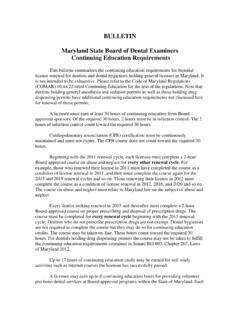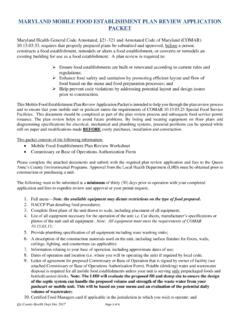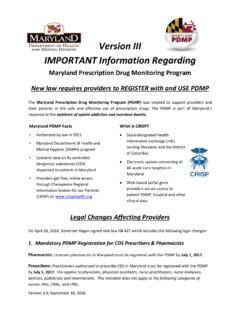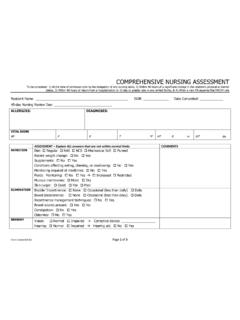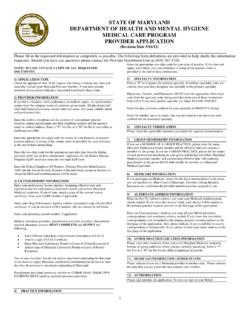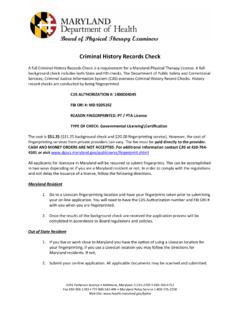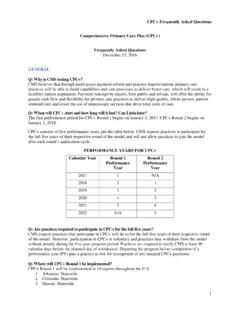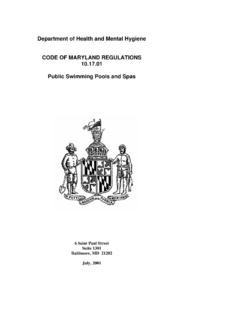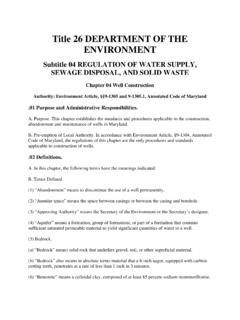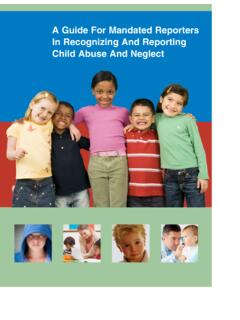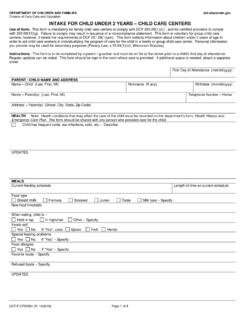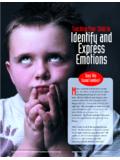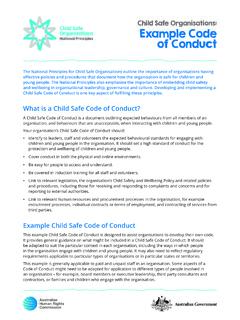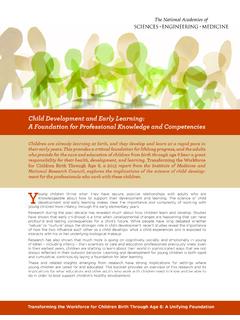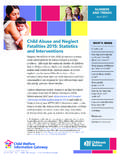Transcription of K-12 School and Child Care COVID- 19 Guidance
1 K-12 School and Child Care COVID- 19 Guidance Revised October 27, 2021. Contents Introduction .. 2. Layered Prevention Strategies to Reduce Transmission of SARS-CoV-2 in Schools and Child Care Programs .. 2. A. Promoting 3. B. Consistent and Correct Mask Use .. 4. C. Physical Distancing .. 4. D. COVID- 19 Testing .. 5. Screening Testing in Schools .. 5. Diagnostic Testing in Schools .. 5. E. 6. F. When to Stay Home and Get Tested .. 7. G. Contact Tracing in Combination with Isolation and Quarantine .. 7. Who Should Isolate .. 7. Who Should Quarantine .. 8. Length of Quarantine .. 9. MDH Modified Quarantine Options for K-12 Schools .. 9.
2 Suspension of In-Person 13. Introduction The following Guidance is provided by the Maryland Department of Health (MDH) and the Maryland State Department of Education (MSDE) to assist local School systems, nonpublic schools, and Child care programs to respond to the COVID- 19 pandemic. The COVID- 19. pandemic continues to rapidly evolve. It is important to frequently check this document and its links for updated information. By law, each local School system, nonpublic School , and Child care program may set their own policies and procedures for their schools, students/children, teachers, and staff. However, MDH and MSDE strongly recommend that these entities work with local health departments to implement the layered prevention strategies ( , using multiple prevention strategies together consistently) needed to protect students/children, teachers, and staff in their setting and adopt policies consistent with the recommendations in this Guidance .
3 For schools, the recommendations in this document are aimed to support opening for in- person learning at full capacity, as recommended by the CDC. Schools should not limit a return to in-person learning at full capacity due to the inability to implement a certain prevention strategy, but rather focus on other layered prevention strategies that can be implemented to keep students and staff safe and ensure continuous full-time, in-person instruction. Where applicable, and for items not discussed in this document, such as cleaning and disinfection practices, sports and other extracurricular activities, and considerations for those with special health care needs, schools and Child care programs should refer to their local health departments and CDC Guidance for COVID- 19 Prevention in K-12 Schools or CDC COVID- 19 Guidance for Operating Early Care and Education/ Child Care for further Guidance .
4 Layered Prevention Strategies to Reduce Transmission of SARS-CoV-2 in Schools and Child Care Programs Schools and Child care programs have mixed populations of both vaccinated and unvaccinated people, and Child care programs primarily serve children who are not yet eligible for vaccination. This makes it critical that schools and Child care programs work with local health departments to determine and implement the layered prevention strategies needed in their area to protect students/children, teachers, and staff. As recommended by the CDC, decisions about layered prevention strategies should be informed by monitoring levels of community transmission, COVID- 19 vaccine coverage, use of screening testing to detect cases in K-12.
5 Schools, ages of children served, and the associated factors that may impact the risk of transmission and feasibility of different prevention strategies. There is no single strategy that, implemented alone , will create a safer School and Child care environment. Instead, MDH and MSDE, in alignment with the CDC, recommend that schools and Child care programs consider implementation of the following layered prevention strategies which should minimize the need 2. to close entire School and Child care buildings, further disrupt learning, and compound the adverse health and emotional stress on children: Promoting vaccination among teachers, staff and students Consistent and correct mask use Physical distancing Screening testing to promptly identify cases, clusters and outbreaks Ventilation Handwashing and respiratory etiquette Staying home when sick and getting tested Contact tracing, in combination with isolation and quarantine Cleaning and disinfection When a School or Child care program cannot implement a certain strategy (ex.)
6 Vaccination for children not yet eligible), it is even more important that other strategies such as consistent and correct mask use and physical distancing be utilized. A. Promoting Vaccination MDH and MSDE strongly recommend that all eligible Marylanders receive a COVID- 19. vaccine. Schools and Child care programs can promote vaccinations among teachers, staff, eligible students/children, and their families; schools and Child care programs interested in learning more about vaccine promotion strategies should refer to their local health departments and CDC Guidance . While vaccination is one of the most critical strategies to help schools resume regular operations, decisions about in-person education should not be based on the level of vaccination of teachers, staff, or eligible students/children.
7 Policies or practices related to requesting, providing, or receiving proof of COVID- 19 vaccination should comply with all relevant laws and regulations. The protocol to collect, secure, use, and further disclose this information should comply with relevant statutory and regulatory requirements, including Family Educational Rights and Privacy Act (FERPA). Existing state law and regulations already require certain vaccinations for children attending School and Child care, and designated School and Child care staff regularly maintain documentation of these immunization records. Similarly, designated staff who maintain documentation of student/ Child and staff COVID- 19 vaccination status can use this information, consistent with applicable laws and regulations, to inform prevention strategies, School -based testing, contact tracing efforts, and quarantine and isolation practices.
8 Schools and Child care programs that plan to request voluntary submission of documentation of COVID- 19 vaccination status should use the same standard protocols that are used to collect and secure other immunization or health status information about students/children. 3. B. Consistent and Correct Mask Use Emergency regulations promulgated by MSDE and the Maryland State Board of Education and approved on 9/14/2021 by the Joint Committee on Administrative, Executive and Legislative Review (AELR), require that all individuals cover their mouth and nose with a face covering while inside a public School facility. For all other schools and for Child care programs, MDH and MSDE, in alignment with CDC.
9 Guidance , strongly recommend the following: Indoor masking for all individuals age 2 years and older, including students/children, teachers, staff, and visitors, regardless of vaccination status Outdoor masking for people who are not fully vaccinated when they are in crowded outdoor settings or during activities that involve sustained close contact with other people Schools and Child care programs should be aware that the federal order that face masks be worn by all people while on public transportation conveyances, including public and private School buses, is still in effect. School and Child care programs should refer to CDC Guidance for important exceptions and additional safety considerations related to the use of masks.
10 C. Physical Distancing Local School systems, nonpublic schools, and Child care programs should follow CDC Guidance for physical distancing. Schools should implement physical distancing to the extent possible, but should not exclude students from in-person learning to keep a minimum distance requirement. For schools, CDC Guidance recommends maintaining at least 3 feet of physical distance between students within classrooms, combined with indoor mask wearing to reduce transmission risk. When it is not possible to maintain a physical distance of at least 3 feet, it is especially important to layer multiple other prevention strategies, such as screening testing, cohorting, improved ventilation, handwashing and respiratory etiquette, staying home when sick, and regular cleaning to help reduce transmission risk.
